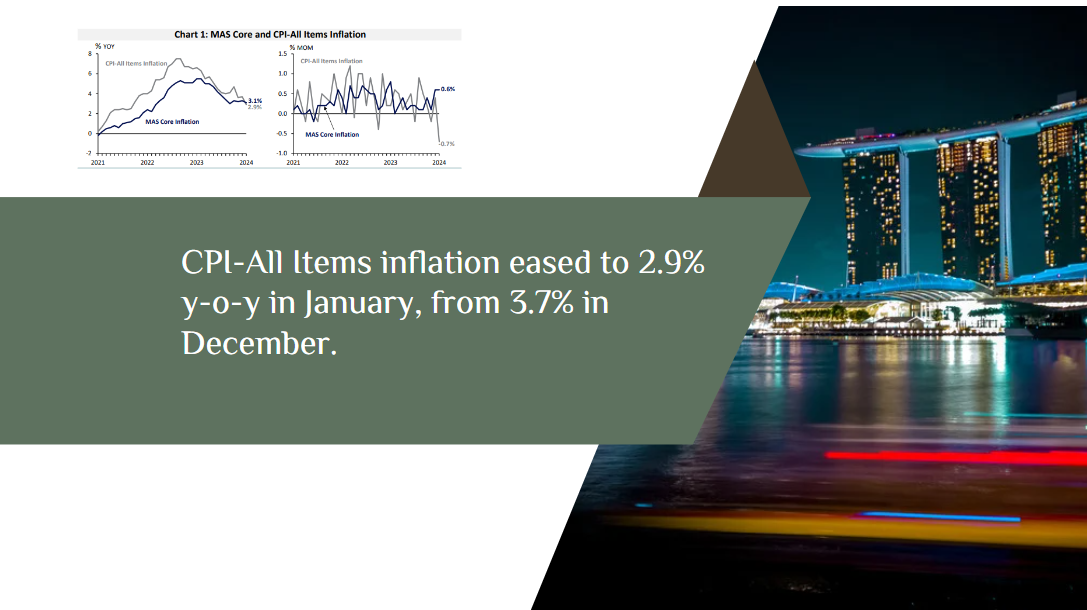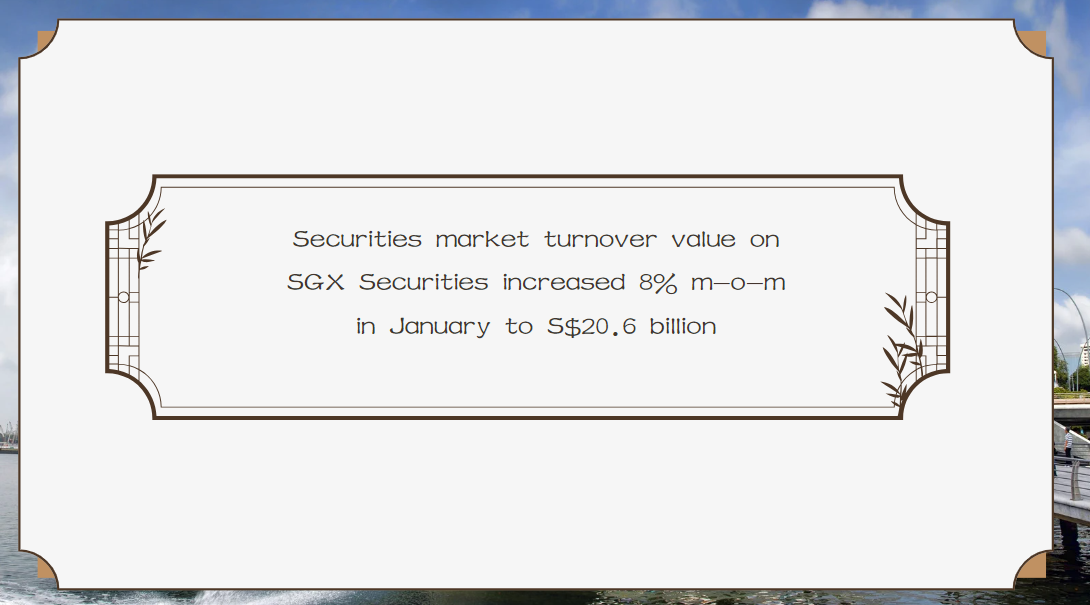Inflation and Monetary Policy
Global Economic Developments: Restoring price stability
Today I would like to discuss the global surge in inflation since 2021 and how central banks, including MAS, have handled it.
·The story is not over, and there will be a lot more forensic analysis of the period.
·But some tentative observations can be made.
The global inflation surge comprised three distinct phases:
·The first phase from 2020-2021. There was an unusual combination of supply- and demand-side shocks. On the supply side, labour markets tightened as renewed demand for labour outstripped the availability of workers. On the demand side, there was a strong resurgence in consumer spending after COVID-19 restrictions were lifted. The interaction of strong demand and weak supply started driving up inflation almost everywhere in 2021.
·The second phase from early 2022. Russia’s invasion of Ukraine led to sharp increases in food, energy, and fertiliser prices. Importantly, these price hikes had a diffused impact on consumer and producer prices.
·The third phase from 2023 onwards. Supply-side pressures receded, helped by commodity price corrections, and by the resolution of many supply chain bottlenecks. As a result, goods price inflation started to fall quickly. However, services price inflation stayed relatively sticky, reflecting higher wage costs, together with a marked shift in post-COVID-19 consumer spending towards services.
Let us consider the seemingly sluggish response of the major central banks to rising inflation pressures.
·It was difficult to anticipate the pickup in headline CPI inflation rates between late-2020 to mid-2021, well before the Russian invasion of Ukraine, which substantially reflected three factors:
·First, supply chain bottlenecks associated with the COVID-19 pandemic. Restoring supply chains after the pandemic proved much more difficult than anticipated, exposing the vulnerability of entire industries to delays in reactivating plants and shipping. Central banks did not expect these disruptions to be so extensive or to last as long as they did.
·Second, structural changes in labour markets. The COVID-19 pandemic severely disrupted labour markets around the world. As a result, traditional indicators of labour market tightness or looseness became less reliable. A few commentators, notably Olivier Blanchard, argued that labour markets, at least in the US, were much tighter than the unemployment rate suggested, but most missed this. [1]
·Third, the strength of consumer demand, in response to their improved financial positions, including from fiscal transfers. When pandemic restrictions were in place, demand for goods was strong, but swung towards services as restrictions were lifted. In both cases, government stimulus measures supported consumption. For instance, while Larry Summers [2] argued that the Biden stimulus package would fuel inflation pressures, almost all forecasters, including at central banks, failed to anticipate the strength and resilience of consumer spending.
Consequently, most central banks missed the whites of the eyes of inflation and were slow to react even as price increases picked up pace.
·MAS’ studies using standard Taylor rules suggest that most advanced economies (AEs) should have started tightening from about mid-2021.
·Perhaps, the notion of looking past transitory supply shocks had become entrenched, but it was more probable that the complexity of simultaneous demand and supply shifts had confounded central banks and other observers.
·Most central banks adopted a “wait-and-see” approach for almost a year, and even those that began to move, did so slowly.
·To be fair, some central banks, including MAS, tightened policy stances in H2 2021, but in most other cases tightening was too slow to have much impact.
Now let me turn to four factors I believe central banks got right.
·We are now in a situation where headline and core inflation are returning to low levels. We’re not all the way back to inflation targets, but closer than many expected us to be at this point, and without having endured a protracted recession. Is this just good luck or have central banks done a good job? In my view it is a combination.
·First, central banks have built up policy credibility. Many central banks, with or without explicit inflation targets, have spent twenty years or more keeping inflation low and stable. Many have had legislative overhauls giving them greater policy autonomy, and all have worked to improve their public communications and policy accountability. All these helped to enhance policy credibility and anchor long-term inflation expectations. In the past three years, we have witnessed that very commitment by central banks and government pay off. Households and markets believed central banks would do what was necessary to restore price stability.
·Second, central banks stood by their inflation targets. There has been no shortage of suggestions that central banks should settle for inflation at around 3-4% indefinitely. [3] While such an approach would certainly allow central banks to declare victory over inflation somewhat earlier than otherwise, it would be a Pyrrhic victory indeed. Far from sparing economic pain, a shift in targets like this would greatly damage policy credibility and blind-side those who have believed in central bank policy commitments, including bond holders and pension funds. That all the major central banks have re-iterated their commitment to inflation targets played a key role in keeping inflation expectations well anchored.
·Third, nimble or flexible policy. Once central banks realised they had an inflation problem, they were primed to move quickly. By early-2022, Taylor rules showed major central bank policy stances were already much too loose. The Russian invasion of Ukraine and the spike in commodity prices shook central banks out of their complacency. In the months that followed, central banks tightened policy stances at an unprecedented rate, much faster than the standard Taylor rule would have indicated. By end-2022, real policy rates, adjusted for inflation expectations, in the major economies were clearly in positive territory.
·This brings me to the fourth point for which central banks deserve credit: some good judgement calls in managing risks. I might note in particular:
·The rapid adjustment of interest rates in H2 2022 and into 2023 did run risks, both of financial instability and of a sharp contraction of economic activity. But too gradual an adjustment ran the risk of allowing price and wage pressures to build and allowing a ratcheting up of inflation expectations. This would have made the disinflation process much more difficult.
·Numerous observers and pundits had also cautioned the major central banks against tightening too little and others against tightening too much. On one side, some pundits argued taming inflation would require inducing a prolonged recession. [4] This school of thought tended to see inflation as being very persistent and inflation expectations as liable to an upward drift. In this case, a sustained period of economic slack would be needed to bring inflation down.
·Another line of argument cautioned against being too aggressive. A concern has been that the adoption of a “data dependent” approach makes policy too backward-looking, and runs the risk of tightening for too long, or not easing soon enough, given the lags between policy actions and their effects on activity and inflation.
·A difficulty with these arguments is that they imply a rather mechanistic approach to policy making. Data rarely tell a clearcut story, and there are many uncertainties about the precise tightness of the labour market, the size of the output gap, the likelihood of new supply chain disruptions, the current value of r-star, whether inflation expectations will remain stable, and so on. Policy makers must weigh all these up in reaching decisions. So far, I would say that the major central banks have done a pretty good job of ensuring that there is sufficient, ongoing restraint on inflation, but not so much as to cause a hard landing. However, monetary policy is just not that precise, and we should not pretend that we can fine tune the exact pace of disinflation.
·And there are still risks. Many commentators are already declaring victory over inflation. The so-called “last mile” may be harder than is generally expected. Markets seem to be more sanguine than central banks. And there are downside risks for economic activity. Weakness in commercial real estate markets in many countries, for example, could pose problems for banks and for credit conditions. And there are some renewed supply chain issues relating to the Middle East conflict.
I might note a few pertinent takeaways from the global monetary policy experience.
·First, inflation is ‘always and everywhere’ a latent vulnerability. Central banks must keep an anxious vigilance over it in accord with their key mandate. This will help anchor price expectations, so critical to maintaining policy credibility and effectiveness.
·If Phillips Curves are relatively flat as some have argued, the primary determinant of actual inflation is expected inflation. [5]
·Second, there are times, especially amid lots of uncertainty, when it pays for the central bank to move cautiously, as in the traditional Brainard Principle. [6] But there are other times when the right thing is to act nimbly.
·Third, inflation is much more than a monetary phenomenon in the short-term. Many factors conspired to ignite and stoke price pressures three years ago; conversely, several factors fortuitously transpired to bring down inflation. Central banks need to hone their understanding of these sorts of developments and how to respond to them.
·Fourth, the pandemic again underscored the point that shocks are typically accompanied by acute stresses on financial stability. Central banks must be prepared to deal with them as guarantor of liquidity. But such actions need to be appropriately circumscribed, and the scope for macroprudential policies should be explored in specific areas of vulnerabilities
Singapore Economy: Pro-equilibrating developments
I will now briefly cover developments in Singapore.
Singapore’s macro developments over 2021–2023 need to be seen in the context of the myriad of shocks to global demand, supply, and international financial conditions.
·From 2019 until the Fed began its tightening cycle in 2022, the 3-month MAS bill yield did not diverge by more than around 50 basis points from the corresponding US rate. [7] A 100-basis-point gap opened up in 2023, and has remained fairly stable since then, broadly consistent with expectations for some nominal appreciation of the Singapore dollar against the US dollar.
·This interest rate convergence may seem to attest to the often-cited thesis of Hélène Rey that there is one global financial cycle driven by developments in the “centre” country. [8] But the recent actions by central banks – either in tightening before the Fed as in Latin America or in declining to follow the Fed as in some Asian countries – show the Rey thesis may not necessarily hold, at least in its strong form.
·The benefit of Singapore’s policy regime is that we still retain the ability to alter exchange rate expectations, and thus domestic monetary conditions, independently of the Fed, and we have in fact taken advantage of this aspect of our policy regime for price stability.
MAS sought to adjust its monetary policy stance in a timely manner as the conjuncture and outlook evolved.
·MAS began tightening monetary policy relatively early in the inflation cycle.
·We withdrew some policy accommodation in October 2021 and again in January 2022 amid the steady post-pandemic economic recovery, as well as the early uptick in inflation.
·It was clear to us that the policy settings that had been in place during the worst of the COVID-19 crisis were no longer appropriate.
·We then followed up with further tightening moves over H1 2022, motivated by the quicker-than-expected acceleration in inflation in the wake of the Russia-Ukraine war.
·The key advantage of acting early and aggressively was that it allowed us to exploit the exchange rate’s role in filtering imported inflation.
·Our econometric simulations show that imported inflation would have been almost 6% on average each year over the past two years, compared to about 2.5% under the actual policy path.
·The global and domestic growth outlook deteriorated and become more uncertain over H2 2022. Nonetheless, we stayed the course in tightening the monetary policy stance amid continued rising import prices and the build-up of domestic cost pressures.
·Overall, MAS tightened monetary policy in five consecutive moves from October 2021 to October 2022, including two off-cycle moves in January and July 2022 as well as three consecutive upward re-centrings of the policy band.
Our progressive tightening of monetary conditions has helped to arrest the momentum of price increases and facilitated a gradual decline in inflation.
·Core inflation has peaked and is expected to continue moderating over the course of this year.
·At our most recent policy review in January, MAS kept the S$ nominal effective exchange rate (S$NEER) on its current appreciating path.
·Even without further changes to monetary policy settings, the S$NEER will likely continue to appreciate gradually within the unchanged policy band.
·In other economies, the monetary policy instrument is the interest rate, which must be set at a specific value rather than on a directional path.
The current policy setting keeps the S$NEER policy band on an appropriately restrictive posture to ensure that core inflation declines to 2% by early 2025.
·This forecast is naturally predicated on no significant exogenous shocks.
My assessment is that the cyclical neutral path of the S$NEER (e-star [9] ) is associated with a non-zero (positive) rate of appreciation.
·In Singapore’s case, such a perspective also allows the exchange rate in levels to follow a trend-stationary path in line with changing relative resource costs and relative productivity differentials, as it converges to its natural steady-state level (e-bar).
·This is different from the interest rate policy regime in the AEs, where attainment of inflation targets in the next 12-month period, is likely to induce a reduction in policy rates, notwithstanding some uncertainty over r-star.
The substantial appreciation of the S$ over the past two years played an important role in bringing Singapore’s demand and supply back into better balance, through expenditure reduction and switching effects.
At the same time, the associated increase in the real effective exchange rate, or the S$REER [10] , has raised some concerns about the impact on Singapore’s export competitiveness.
·While the Singapore economy registered a string of weak export readings from late-2022 into 2023, our empirical work suggests that these were driven mainly by lacklustre external demand, rather than by a loss of external competitiveness.
·The global electronics industry entered a cyclical downturn last year, on the back of a boom in 2022. Given tepid external demand, a weaker Singapore dollar would not have provided much of a boost to exports.
·Overall, the downturn and recent nascent recovery in Singapore’s electronics exports has been broadly in line with other major electronics producers in the region.
·In fact, if MAS had not tightened monetary policy, domestic overheating and the passthrough of higher global prices would have kept inflation in Singapore higher for much longer. This would have come at a significant cost to households and firms.
·MAS’ model simulations show that without the filtering effect of a higher nominal exchange rate, import prices would have risen at a faster pace. Stronger aggregate demand, at a time when the labour market was already at its limits, would also have put upward pressures on wage costs.
·The domestic economy would have experienced a spell of persistently high inflation, with headline CPI inflation reaching 8% y-o-y in some quarters (compared to the actual peak of 7.3% in Q3 2022).
·Sharply higher wages and costs, as the economy is pushed well beyond its absorptive limits, would eventually have led to substantially lower real GDP growth.
·The risks of a wage-price spiral arising from persistently elevated inflation would also have been higher.
The alternative to the necessary appreciation of the S$REER through the S$NEER rise, would have been to let higher domestic inflation do more of the work.
·Our model simulations confirm that in a counterfactual scenario where MAS did not raise the nominal exchange rate, the S$REER would still have appreciated as much as it did from MAS’ tightening moves, albeit with a lag and driven mainly by increases in relative prices—that is, domestic consumer prices rising by more than foreign prices.
·This alternative would have been clearly sub-optimal.
·Accordingly, the contribution of monetary policy was to manage the S$REER appreciation in an optimal manner.
Over the longer-term, the real exchange rate will reflect the strength and prospects for Singapore’s underlying economic fundamentals compared with those of trade partners and competitors.
·Singapore’s economic competitiveness is anchored by many other factors besides the exchange rate or absolute cost comparisons.
·The appreciation of the Singapore dollar is not necessarily a deterrent to investment nor a liability to growth.
·The quality of our human capital, infrastructure, connectivity, and institutions, among other factors, speak for themselves.
·Singapore’s tradable sectors have been able to adapt to higher costs through efficiency gains, and by shifting into industries that can command a higher premium (or terms of trade) in the global markets.
·These factors continue to place Singapore in a good position to benefit from shifts in global production and trade, as geopolitics evolve and supply chains reconfigure.
With that, I thank you for your kind attention and wish you all a productive conference.
[1] Blanchard, Olivier (2022), “Realtime Economics: Why I worry about inflation, interest rates, and unemployment”, Peterson Institute for International Economics (PIIE), March 14.
[2] Collins, Peggy (2021), “Summers Warns U.S. Risks Rising Inflation Amid Massive Stimulus”, Bloomberg, March 27.
[3] Blanchard, Olivier (2022), “Opinion US inflation: It is time to revisit the 2% inflation target”, Financial Times, November 29.
[4] Please see Barrabi, Thomas (2022), “Larry Summers says unemployment must hit 6% for Fed to tame inflation”, New York Post, October 6., and Cecchetti, Stephen. et al. (2023) “Managing Disinflations”, CEPR Discussion Paper 18068, April.
[5] Clarida, Richard H. (2020), “The Federal Reserve’s New Monetary Policy Framework: A Robust Evolution”, Peterson Institute for International Economics, August 31.
[6] Frequently referred to as the “Brainard conservatism principle”, it outlines that under conditions of uncertainty, policy should move in the direction needed but not as aggressively as otherwise taken under conditions of certainty. Please see Brainard, William C (1967), “Uncertainty and the Effectiveness of Policy”, American Economic Review, 57(2), pp.411-425
[7] Market participants generally perceive the 3-month MAS bill and 3-month US Treasury bill rates to be appropriate short-term risk-free rates.
[8] Rey, Hélène (2013), “Dilemma not trilemma: the global financial cycle and monetary policy independence”, Federal Reserve Bank of Kansas City Economic Policy Symposium.
[9] The distinction between e-bar and e-star is similar to that made by Obstfeld between the natural interest rate (r-bar) and neutral rate (r-star). The former refers to the real rate of interest over a long-run equilibrium free from price rigidities while the latter is the real policy rate of interest extinguishing inflationary or deflationary pressures. Please see Obstfeld, M. (2023) “Natural and Neutral Real Interest Rates: Past and Future”, National Bureau of Economic Research (NBER) Working Paper 31949, November.
[10] The S$REER is defined as the cost of a unit of goods and services in Singapore relative to a similar unit in other countries. It is computed by adjusting the S$NEER for the price level in Singapore relative to that in its major trading partners.























































First, please LoginComment After ~